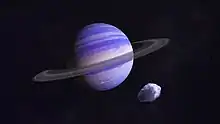Gliese 15 Ac
Gliese 15 Ac (also known as Groombridge 34 Ac) is an exoplanet orbiting the nearby red dwarf star Gliese 15 A (Groombridge 34 A), which is part of a binary star system located about 11.6 light-years[3] from the Sun. The planet was first proposed in October 2017 using radial velocity data from the CARMENES spectrograph, combined with measurements from the HARPS and HIRES spectrographs,[4] and its existence was confirmed in April 2018 using HARPS-N data.[1] It has a minimum mass 36 times that of Earth and orbits at around 5.4 astronomical units with a period of 7,600 days (21 years), an orbit which may have been sculpted by interaction with the companion star, Gliese 15 B.[1][5] As of 2020, Gliese 15 Ac is the longest-period sub-Jovian planet discovered by radial velocity.[1][2]
 Artist's impression of a Neptune-type exoplanet like Gliese 15 Ac. | |
| Discovery[1] | |
|---|---|
| Discovered by | Pinamonti et al. |
| Discovery site | HARPS-N |
| Discovery date | April 2018 |
| Radial velocity | |
| Designations | |
| Groombridge 34 Ac | |
| Orbital characteristics | |
| 5.4+1.0 −0.9 AU[1] | |
| Eccentricity | 0.27+0.28 −0.19[1] |
| 7600+2200 −1700 d[1] | |
| −58.40+100.80 −53.30[1][2] | |
| Semi-amplitude | 2.5+1.3 −1.0[1] |
| Star | Groombridge 34 A |
| Physical characteristics | |
| Mass | ≥36+25 −18 M⊕[1] |
References
- Pinamonti, M.; Damasso, M.; Marzari, F.; Sozzetti, A.; Desidera, S.; Maldonado, J.; Scandariato, G.; Affer, L.; Lanza, A. F.; Bignamini, A.; Bonomo, A. S.; Borsa, F.; Claudi, R.; Cosentino, R.; Giacobbe, P.; González-Álvarez, E.; González Hernández, J. I.; Gratton, R.; Leto, G.; Malavolta, L.; Martinez Fiorenzano, A.; Micela, G.; Molinari, E.; Pagano, I.; Pedani, M.; Perger, M.; Piotto, G.; Rebolo, R.; Ribas, I.; et al. (2018). "The HADES RV Programme with HARPS-N at TNG. VIII. GJ15A: A multiple wide planetary system sculpted by binary interaction". Astronomy and Astrophysics. 617: A104. arXiv:1804.03476. Bibcode:2018A&A...617A.104P. doi:10.1051/0004-6361/201732535.
- "GJ 15 A c". NASA Exoplanet Archive. Retrieved 1 August 2020.
- Brown, A. G. A.; et al. (Gaia collaboration) (August 2018). "Gaia Data Release 2: Summary of the contents and survey properties". Astronomy & Astrophysics. 616. A1. arXiv:1804.09365. Bibcode:2018A&A...616A...1G. doi:10.1051/0004-6361/201833051. Gaia DR2 record for this source at VizieR.
- Trifonov, T; Kürster, M; Zechmeister, M; Tal-Or, L; Caballero, J; Quirrenbach, A; Ribas, I; Reiners, A (2018). "The CARMENES search for exoplanets around M dwarfs. First visual-channel radial-velocity measurements and orbital parameter updates of seven M-dwarf planetary systems". Astronomy & Astrophysics. 609: A117. arXiv:1710.01595. Bibcode:2018A&A...609A.117T. doi:10.1051/0004-6361/201731442.
- Brennan, Pat. "Discovery Alert: 2-planet System Is Close – and Weird". NASA. Retrieved 1 August 2020.